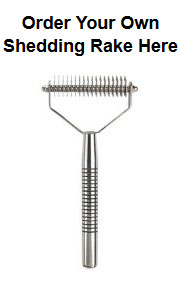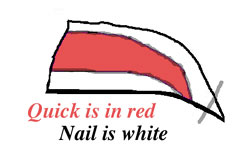
The German Shepherd Dog (GSD, also known as an Alsatian), (German: Deutscher Schäferhund) is a breed of large-sized dog that originates from Germany. German Shepherds are a fairly new breed of dog, with their origins only dating back to 1899. Part of the herding group, shepherds are working dogs developed originally for herding sheep. Their strength, intelligence and obedience often sees them employed in police and military roles in forces around the world. Due to their loyal and protective nature the breed is among the most registered.
It is handsome, well proportioned and very strong. The coat most often comes in black with tan, sable or all black, but also can come in blue, liver and white, but those colors are considered a fault according to most standards. White is not an acceptable color for the German Shepherd, however they are now being recognized as a separate breed, called the American White Shepherd. The nose is black most often black but, blue or liver still do sometimes occur, but is considered a fault can not be shown. It has a sturdy, muscular, slightly elongated body with a light but solid bone structure. Its head should be in proportion to its body, and the forehead a little convex. It has a strong scissors bite, ears wide at the base, pointed, upright, and turned forward (the ears of puppies under six months may droop slightly). The eyes are almond-shaped, never protruding, dark, with a lively, intelligent expression. Its bushy tail reaches almost to its hocks and hangs down when the dog is at rest. Its front legs and shoulders are muscular; its thighs thick and sturdy. It has round feet with very hard soles. There are three varieties of the German Shepherd: rough-coated, long rough-coated, and the long-haired.
![]()
 Purebred dogs are measured against a breed standard of perfection, a written description of what the ideal specimen should look like. Each dog-registering organization has its own set of standards, one for each of the breeds it recognizes; however, these standards may vary, in the way they are worded, from registry to registry and from country to country.
Purebred dogs are measured against a breed standard of perfection, a written description of what the ideal specimen should look like. Each dog-registering organization has its own set of standards, one for each of the breeds it recognizes; however, these standards may vary, in the way they are worded, from registry to registry and from country to country.
THE RIGHT TEMPERAMENT
Without question, the German Shepherd Dog's temperament and intelligence has earned it an international fan club. Its affable, easy-going nature gives way to a strong protective instinct when provoked. People close to the breed frequently claim that German Shepherds know right from wrong and that a well-trained GSD is the best roommate you could ask for.
Characterized by a direct and fearless expression, the German Shepherd never appears hostile, but instead appears self-confident, with a certain aloofness. While maintaining this aloofness, the German Shepherd must be approachable, quietly standing his ground and showing confidence and willingness to meet overtures without making them himself.
The traits of keen intelligence and trainability have made the German Shepherd arguably the most versatile breed in history. In addition to their traditional roles as police and herding dogs, the breed has encountered success in many areas including watchdog, leader of the blind, tracking, rescue, scent identification, agility, obedience, guardian, and of course companion. He is poised and calm, but when the occasion presents itself he can be alert and startling.
The AKC breed standard is eloquent and detailed in its description of the ideal dog. It reflects the German Shepherd's utility as a guardian and a working dog. An ideal German Shepherd Dog is lively and alert; his body is well-muscled, agile, and powerful. This well-balanced dog is usually longer than he is tall and deep-bodied. He looks substantial and not spindly, giving the impression of muscular fitness whether at rest or in motion. He also appears nimble and never clumsy or flabby. Although difficult to define, the German Shepherds’ look of nobility is unmistakable when present.
Dogs measure 24 to 26 inches tall at the shoulder, bitches measure between 22 and 24 inches. The correct proportion is 10-to-8 ½ (length-to-height), forming a body that is "slightly elongated, strong and well-muscled. The bone is clean and general construction firm."
German Shepherds are a large-breed dog which generally are between 55 and 65 centimetres (22 and 26 in) at the withers and weigh between 22 and 40 kilograms (49 and 88 lb). The ideal height is 63 centimetres (25 in), according to Kennel Club standards. They have a domed forehead, a long square-cut muzzle and a black nose. The jaws are strong, with a scissor-like bite. The eyes are medium-sized and brown with a lively, intelligent, and self-assured look. The ears are large and stand erect, open at the front and parallel, but they often are pulled back during movement. They have a long neck, which is raised when excited and lowered when moving at a fast pace. The tail is bushy and reaches to the hock.
The whole body gives the impression of depth and solidity without bulkiness. The AKC standard defines the German Shepherd chest as deep and capacious, never shallow, with ample room for lungs and heart."
The rib cage is "well-sprung and long, neither barrel-shaped nor too flat." The correct rib layout allows the dog's elbows to move freely when the dog trots. The loin is relatively short with only a slight tuck up, and the stomach is flat and firm.
As with any working breed, the shoulder blades are long and well-laid-back. The shoulder blade and the upper arm are well-muscled, leading to straight forelegs. The front legs from all sides are straight and strong with oval rather than round bone. The pasterns are strong and springy, angulated at 25 degrees from the vertical. The GSD feet are short and compact, with well-arched toes; thick, firm foot pads; and short, dark nails.
Strong without coarseness, the head is noble and cleanly chiseled. The muzzle is long and strong with the lips firmly fitted; the forehead is only moderately arched, and the skull slopes into the long, wedge-shaped muzzle without abrupt stop. The GSD muzzle is straight in profile, with a predominantly black nose. A clean scissor bite is vital to a German Shepherd, allowing its teeth to be strongly embedded. The strongly developed jaw should carry 42 teeth, 20 upper and 22 lower. The eyes are medium-sized and almond-shaped, set a little obliquely and not protruding. The darkness of the eyes gives the breed a keen and intelligent expression.
The medium-sized ears taper to a moderate point and are carried erect unless the dog is moving or in repose. The ears should be as straight as possible, with the ideal ears, viewed from the front, showing parallel straight centerlines that are perpendicular to the ground.
From the head, the GSD standard calls for a strong, relatively long neck that ties into the topline of the back at the dog's withers, which are higher than the back. The withers slope down in a smooth line to a straight back, with neither a sag nor roach in profile, and into a long, gradually sloping croup (buttocks).
The topline ends in a gently curved tail. The German Shepherd's bushy tail reaches at least to the dog's hocks, hanging in a gentle curve. Even when in motion, the tail is never to be held above horizontal, but it may curl more tightly.
The dog's back and topline are vital to the smooth trotting ability and strength of the German Shepherd. The standard emphasizes, "The typical smooth, flowing gait is maintained with great strength and firmness of back. The whole effort of the hindquarter is transmitted to the forequarter through the loin, back and withers. At full trot, the back must remain firm and level without sway, roll, whip or roach…the shoulder should open to its full extent. The forelegs should reach out close to the ground in a long stride in harmony with that of the hindquarters."
Because German Shepherds were intended to cover lots of ground, gait and its way of going are important. The AKC standard devotes more attention to this area than to any other. "The gait is out-reaching, elastic, seemingly without effort, smooth and rhythmic, covering the maximum amount of ground with a minimum of steps. At a walk, it covers a great deal of ground, with long stride of both hind legs and forelegs. At a trot, the dog covers still more ground with even longer stride ... the gait appears to be the steady motion of a well-lubricated machine."
All the German Shepherd's power to run, jump and climb comes from its hindquarters, which makes them vitally important to the dog's conformation. The hindquarters deliver, through the back, a powerful forward thrust that slightly lifts the whole animal and drives the body forward. Reaching far under, and passing the imprint left by the front foot, the hind foot takes hold of the ground; then hock, stifle and upper thigh come into play and sweep back, the stroke of the hind leg finishing with the foot still close to the ground in a smooth follow-through."
The angulation of the dog's hind limbs, therefore, directly affects the quality of its gait. The broad upper and lower thighs should be strong and well-muscled, forming as nearly as possible a right angle.
German Shepherds can be a variety of colours, the most common of which are the tan/black and red/black varieties. Both varieties have black masks and saddles. Rarer variations include the sable, all-black, all-white, liver and blue varieties. The all-black variety is acceptable; however, the blue and liver are considered to be serious faults and the all-white is grounds for instant disqualification in some standards. This is because the white coat is more visible, making the dog a poor guard dog, and harder to see in conditions such as snow or when herding sheep.
German Shepherds sport a double coat. The outer coat, which is shed all year round, is close and dense with a thick undercoat. The coat is accepted in two variants; medium and long. The long-hair gene is recessive, making the long-hair variety rarer. Treatment of the long-hair variation differs across standards; they are accepted under the German and UK Kennel Clubs but are considered a fault in the American Kennel Club
COAT AND COLORS
The ideal German Shepherd Dog has a double coat of medium length. The top coat is dense and harsh, covering a light gray undercoat, which should not be visible through the top coat. The dog's hair is slightly longer and coarser on its neck and the back- sides of its legs.
The German Shepherd Dog varies in color, and mostly rich colors are preferred. Acceptable colors include, black and tan, black and red, black and cream, solid black, sable, and black and silver. Sables bear multi-colored individual hairs, which may be masked by dark or black guard hairs. White dogs must be disqualified. Pale, washed out colors and blues and livers are considered serious faults. Other faults are soft, silky, wooly, curly or too long outer coats.





 German Shepherd Dogs with white coats are not accepted by many kennel clubs, particularly the AKC. Despite this, the snowy shepherd has a worldwide following that is pushing to have it recognized as a separate breed or as a viable color for the GSD. There are two clubs in North America that promote the white German Shepherd.
German Shepherd Dogs with white coats are not accepted by many kennel clubs, particularly the AKC. Despite this, the snowy shepherd has a worldwide following that is pushing to have it recognized as a separate breed or as a viable color for the GSD. There are two clubs in North America that promote the white German Shepherd.